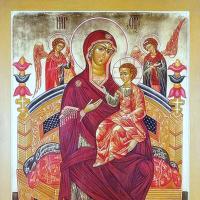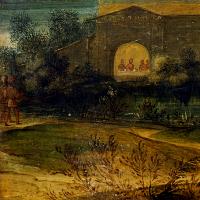Story. Holy Dormition Princess Convent - Vladimir - history - catalog of articles - love without conditions St. Princess Maria Shvarovna
The Dormition Princess Monastery in Vladimir is an Orthodox convent founded at the beginning of the 13th century and today is a functioning convent of the Vladimir and Suzdal diocese. The white-stone Assumption Cathedral of the monastery is an architectural monument included in the list of objects of the Vladimir-Suzdal Museum-Reserve.
Princess's monastery
XII century... The time of rapid prosperity of Vladimir, a city that at that time was not only the capital of the Vladimir-Suzdal principality, but also the main city of all north-eastern Rus'. The prosperity of the capital of the principality is associated with the name of Prince Vsevolod Yuryevich the Big Nest, who headed the Vladimir principality in 1176. Thanks to Prince Vsevolod, the capital of the principality was decorated with many architectural monuments that have survived to this day - the Assumption and Demetrius Cathedrals, the Nativity of the Virgin Monastery.
But a special place in this list is occupied by the Dormition Princess Monastery, founded by the first wife of Vsevolod the Big Nest, Maria Shvarnovna (daughter of the Czech Prince Shvarn). According to the chronicles, in 1197, after the birth of her youngest son Ivan (in the future, the appanage prince of Starodub), the pious and wise princess became very ill, so she vowed to found a maiden monastery in Vladimir. Yielding to the urgent requests of his wife, Vsevolod Yuryevich allocated an undeveloped area in the northwestern part of the city, and in 1200 a new monastery was founded and dedicated to the feast of the Dormition of the Blessed Virgin Mary. And soon after its founding, the monastery received a second name - Princess, which it retained many centuries later.
The princess was under the care of the nunnery, so in the same year, 1200, the construction of the majestic Assumption Cathedral, the main monastery church, was begun in the new monastery, completed in 1202. In addition to the cathedral, the monastery received cells for the abbess and nuns, and outbuildings. And three years after the consecration of the cathedral church, Princess Maria Shvarnovna, feeling her death was imminent, took monastic vows with the name Martha and retired to the Assumption monastery she founded, where after her death she was buried in the Annunciation chapel, built on the northern porch. Since then, the Assumption Princess Monastery has become the family tomb of the princesses, sisters and daughters of the princely Vladimir family, and the most famous burials were the graves of Princess Anna’s sister, both wives of Prince Alexander Nevsky (Alexandra and Vassa), who was Maria Shvarnovna’s grandson, and his daughter Evdokia.
In 1230, in memory of his mother, Prince Yuri (George) Vsevolodovich of Vladimir brought the relics of the holy martyr Abraham of Bulgaria to the Assumption Monastery from the Bulgarian campaign and installed them in the Annunciation chapel. The relics rested there until 1711, when they were solemnly transferred to the main chapel of the cathedral and placed in a new richly decorated reliquary.
Soon after its founding, the Princess Monastery became the richest and most famous women's monastery in Rus', and its nuns became a model of piety and obedience. Life in the well-maintained and well-decorated Princess Nunnery monastery flowed slowly and measuredly, but the thick walls of the monastery could not protect the nuns from the storms of life. In February 1238, after an eight-day siege, Batu’s Tatar army broke into the city and the monastery located near the Golden Gate was plundered and almost completely burned, but was soon completely restored.
More than once the Assumption Monastery was completely destroyed, but each time, like the mythical Phoenix bird, it was reborn from the ashes. But after the largest-scale defeat perpetrated by the horde of the Tatar prince Talych in 1411, life in the Princess’s monastery froze for a whole century. The monastery was revived only at the beginning of the 16th century, when a new brick church was built on the foundation of the destroyed Assumption Cathedral, following its example. The cathedral, built in the style of early Moscow architecture, became the decoration of the monastery. An unknown architect surrounded the facades of its massive quadrangle with three high apses with a gallery, completed it with zakomaras, framed the base of the light drum with tiers of kokoshniks and crowned it with a powerful helmet-shaped head with a cross on an apple. No information has been preserved about the interior decoration of the cathedral from those years, but it can be assumed that it was quite luxuriously decorated with icons and church utensils.
Documents from the 16th century contain written references to another monastery warm church, consecrated in the name of John Chrysostom, but nothing more is known about its further fate until the 19th century.
In the middle of the 16th century, a tradition arose of presenting letters of grant to the maiden monastery. For example, Tsar Ivan IV the Terrible not only granted land to the Princess's monastery, but also personally took care of the improvement of the monastery, and during the years of his reign, the queen's mansion was equipped in the monastery, for the maintenance of which the Vladimir governor was personally responsible. Royal guests periodically appeared in the mansions - the daughter-in-law of John IV Vasilyevich (wife of Tsarevich Ivan), Theodosia (in some sources - Pelageya) Mikhailovna and Ksenia (daughter of Tsar Boris Godunov).
In the 1540-1550s, when Patriarch Joseph of Moscow and All Rus' was the head of the Church, the nunnery began to be improved. Thanks to the personal donations of Patriarch Joseph, a new iconostasis was built in the Assumption Cathedral of the monastery, icons were painted, priestly vestments and church vessels were purchased for divine services, and the sacristy was replenished with rich utensils. The patriarch also donated for the repair of monastery buildings - the roofs of all the churches were covered, the walls were decorated with paintings, a bell tower was built, for which two evangelistic bells were purchased especially, and the entire complex of monastery buildings was surrounded by a fence. Apparently, at the same time a school of gold embroidery was created in the monastery, which existed until the abolition of the monastery at the beginning of the last century.
About the fate of the monastery in the 17th-19th centuries
With the death of Ivan the Terrible, the era of Rurik rule ended and the Russian kingdom was swallowed up by the Troubles - a cruel and bloody time that brought many troubles and suffering. The Lithuanian and Polish invaders, scouring the vast Russian expanses in search of easy money, could not ignore the nunnery - the Princess's monastery was plundered and life in it died out for many decades.
But already the first Romanov sovereigns, Mikhail Fedorovich and Alexei Mikhailovich, not only began the gradual revival of the nunnery, but also continued the tradition of gifting the monastery with letters of grant. The new kings made rich contributions to the monastery sacristy and donated large sums to maintain churches and buildings in proper condition. So, in 1647-1648, the Assumption Cathedral was decorated - a team of craftsmen under the leadership of the famous Moscow isographer Mark Matveev painted all the walls and vaults with fresco paintings of Gospel scenes, and in 1665 the Nativity chapel was added to the cathedral.
By the beginning of the 18th century, the Dormition Princess Monastery was one of the most comfortable convents for women, its nuns did not need anything - the vast lands and patrimonial villages provided a good income, and generous donors helped maintain the buildings of the monastery ensemble in order.
Information for visitors
- The Assumption Princess Monastery is open to pilgrims and tourists every day from 8.00 to 20.00. Every day, on Sundays and holidays, divine services are held in the monastery’s churches and church services are performed.
- For everyone, daily from 11.00 to 17.00 the monastery conducts excursions, which can be ordered by calling the number listed on the official website of the monastery.
The Holy Dormition Princess Monastery in Vladimir has always been called a “women’s” tomb in Rus'. It was founded in 1200 by the wife of Prince Vsevolod, Maria. The great woman, who gave birth to 12 children, personified an example of holiness and virtue. And the monastery founded by her was very rich and famous.
Immediately after its foundation, a tradition began to bury princesses and women of noble families in the monastery. The last refuge was found in the Princess Monastery by the founder of the monastery herself, her sister, the daughter of Alexander Nevsky Evdokia and the wives of Prince Vassa and Alexander. Already in the 18th century, the sister of the great Russian admiral Mikhail Lazarev was buried in the monastery.
At the beginning of the 15th century, the Tatar prince Talych destroyed the monastery. Like a plague, like a black whirlwind, it swept through the Princess Monastery, and the holy place was empty for more than a hundred years. In the 16th century, the monastery began to be revived. Grand dukes and kings invested their own money to reopen the monastery. Ivan the Terrible kept this charitable deed under his strict control.
His wife Pelagia also lived in the Princess Monastery for some time. The Vladimir governor was responsible for the so-called “tsarina’s” mansions, which were located within the walls of the monastery. Everything there had to correspond to the high status of the inhabitants. By the way, they loved the Princess's monastery and Boris Godunov's daughter Ksenia.
In the second half of the 19th and early 20th centuries, the monastery was famous for its charity. The nuns created a hospital for the poor, a handicraft school for girls from low-income families, beggars and cripples found shelter here. In 1900, the monastery celebrated its 700th anniversary, and in 1923 it was practically wiped off the face of the earth.
The princess's monastery came under severe repression, the nuns were expelled, absolutely everything was plundered, even the monastery cemetery was destroyed. Workers of the Communist Party settled in the cells, and the place where the monastery stands was renamed the Vorovsky village. The Princess Monastery was revived in 1992 and placed under the jurisdiction of the Vladimir diocese.
The Assumption Cathedral deserves special attention. Although it was founded in the 12th century, a later copy of the temple, erected on an ancient foundation, has survived to this day. Miraculously, the amazingly beautiful paintings on the walls, which were made in the 17th century by famous Russian masters led by Mark Matveev, have survived to this day.
Today people come to the Holy Dormition Princess Monastery not only to admire the frescoes, but also to venerate two of the greatest shrines - the relics of Abraham of Bulgaria and the icon of the God-loving Mother of God. This icon was painted on the personal instructions of Prince Andrei.
Dormition Princess Monastery in the photo
Address: 600000, Vladimir, st. Princess Monastery, 37A
Assumption Cathedral of the Assumption Princess Monastery in Vladimir.
Shrines of the monastery:
Bogolyubskaya Icon of the Mother of God.
On the northern porch of the Assumption Cathedral, where the Annunciation chapel is now located, the founder of the monastery, Grand Duchess Maria Shvarnovna, in the schema of Martha, was buried. On Sundays, a prayer is read at her tomb, the troparion, kontakion and magnification are sung. Many revere the holy princess, pray to her and receive help from her.
Grand Duchess Maria was glorified in the Cathedral of Vladimir Saints - June 23 / July 6. The monastery still celebrates the day of her death on March 19/April 1. The lithium is served, the troparion and kontakion are sung.
Icon of the great martyr and healer Panteleimon.
With the blessing of Archbishop Eulogius and the petition of Abbess Anthony, in 1999 an icon of the great martyr and healer Panteleimon was painted on Holy Mount Athos, in the monastery of Righteous Anna. Through the diligence of the rector of the Athos metochion in Moscow, abbot Nikon (Smirnov), the icon was delivered to Vladimir. Here, at the walls of the Princess's monastery, she was greeted with a religious procession.
![]()
Icon of the great martyr and healer Panteleimon in his life. The end of the 20th century. Located in the Assumption Cathedral of the monastery.
In the autumn of the same year, with the blessing of Bishop Eulogius, the icon of the Great Martyr Panteleimon was carried in a religious procession throughout the diocese. And immediately miracles began to flow from her - healings, the flow of myrrh, the consolation of the grieving and the relief of everyday hardships. Upon returning to the monastery, the icon was decorated with hagiographic stamps, a silver reliquary with a particle of the relics of St. Panteleimon was inserted into it, and a carved wooden icon case was arranged.
In 2005, with the blessing of Bishop Eulogius, the icon was again carried in a religious procession throughout the diocese. And healing, consolation and gracious help flowed from her again. The icon began to stream myrrh again, and the stream of myrrh continues to this day.
Final word.
On the tenth of April 1993, on Lazarus Saturday, His Eminence Archbishop Eulogius consecrated the Assumption Cathedral of the Princess Monastery. 14 years have passed since then, over the years the appearance and internal life of the monastery have changed a lot. Four nursing buildings, an orphanage and a regency school were rebuilt, and the monastery church in honor of the Kazan Icon of the Mother of God was restored. In 2008 we will celebrate the 15th anniversary of the resumption of monastic life at the monastery. Now 29 nuns live and work in the monastery: 11 nuns, 11 nuns, 4 novices and 3 laborers who are passing the test to enter the monastery. The oldest who reposed in the Lord in 2007, nun Christina, was 97 years old, the youngest sister was 22 years old. The monastic life of the monastery proceeds according to the charter approved by the ruling Archbishop Eulogius. Labor obediences are closely connected with prayer.
In recent years, we have celebrated three important dates associated with the glorious history of the monastery. In 2000 - the 800th anniversary of the opening of the monastery, in 2003 - the 10th anniversary of the newly opened monastery, in 2006 - the 800th anniversary of the death of its founder - Grand Duchess Maria Shvarnovna.
In 2007, the Vladimir diocese hosted celebrations associated with the 850th anniversary of the painting of the Bogolyubsk Icon of the Mother of God. This day is especially dear to the sisters, since the opening of the monastery began from the day when the greatest shrine of the Russian land, the Bogolyubskaya Icon of the Mother of God, was transferred to these walls.
We are grateful to everyone who helped us during the difficult years of the formation of the monastery, and we will be glad to welcome everyone who wants to visit our holy monastery.
Using materials from the book “Holy Dormition Princess Convent in Vladimir.”
Since 1200, the Dormition Princess Monastery has been included in the list of monasteries in the Vladimir region. The monastery was founded in 1200 by the first wife of Grand Duke Vsevolod Georgievich (Yuryevich) - Grand Duchess Maria Shvarnovna. In 2000, the 800th anniversary of the founding of this, one of the most famous Russian monasteries, was celebrated. The organizer of the Princess Monastery (in monasticism - Schema-nun Martha) presented herself as an image of Russian holiness. Her descendants also became famous as saints - sons George, Yaroslav (in holy baptism - Theodore), Svyatoslav and Konstantin Vsevolodich, grandchildren Alexander Nevsky and Feodor (sons from Yaroslav), Vasilko (from Constantine), sons of George, great-grandson along the line of Alexander Nevsky - Daniil Moskovsky and others. Grand Duchess Maria herself was also glorified in the Cathedral of Saints who shone in the land of Vladimir. In ancient times, the Princess Monastery was one of the most famous and rich. The name of the monastery is connected both with the fact of its foundation by Grand Duchess Maria Shvarnovna, and with the tradition of burial within the walls of the main cathedral of the monastery, dedicated to the feast of the Dormition of the Mother of God of the Grand Duchesses and their daughters. Here are the burial places of the founder herself, her sister Anna, the daughter of Grand Duke Alexander Nevsky Evdokia and his wives Vassa and Alexandra, the wife of Yaroslav Vsevolodich Elena. At a later time, the sister of the discoverer of Antarctica, Admiral M.P., rested here. Lazareva - V.P. Lazarev. As we can see, the history of the monastery is closely connected with the most important events of Russian history and the capital status of the city of Vladimir in ancient times.
In 1411, during the invasion of Vladimir by the Tatars under the leadership of Tserevich Talych, the monastery was destroyed. The revival of the monastery began only in the 16th century. Among the investors of the monastery, the Grand Duke Vasily Ioannovich and the kings: Ivan the Terrible, Mikhail Feodorovich, Alexei Mikhailovich are mentioned. The wife of Tsarevich Ivan (son of Ivan the Terrible), Pelagia Mikhailovna, stayed in the Princess Monastery for some time. Since 1606, the daughter of Tsar Boris Godunov, Ksenia, also lived in the monastery, who later accepted monasticism with the name Olga. In the 17th century, the monastery had special Tsarina’s mansions, for the maintenance of which the Vladimir governor was responsible. Since the beginning of the 18th century, as a result of the reforms of Peter I and later Catherine II, the monastery has been experiencing a period of some decline. The monastery experienced a new stage of revival in the 19th - early 19th century. XX centuries. At this stage, works of charity and mercy become a characteristic feature of the monastery. In 1876, a hospital for the poor was created there. In 1889, a parochial handicraft school for girls from poor families was opened here. In 1900, the monastery solemnly celebrated the 700th anniversary of its historical existence.
In 1923, the Princess Monastery was forcibly closed by the repressive bodies of the Soviet government: the liquidation of the monastery was carried out over eight months from March to November 1923 and was accompanied by the looting of the property of the monastery and its nuns. The nuns were expelled from their cells, which were given over to responsible officials of the Soviet government and the Communist Party for settlement. In connection with the closure of the monastery and the creation of a village for the new bureaucratic elite, the monastery cemetery was also liquidated. In 1923, the Princess Monastery as a territorial unit within the city’s borders was renamed the village named after Vorovsky.
In 1992, the Dormition Princess Monastery was again revived as a monastic monastery for the Vladimir diocese. Nun Antonia (Shakhovtseva) became the abbess of the monastery. In the Assumption Cathedral of the Princess Monastery, wonderfully painted in the 17th century. a team of famous masters, there are the greatest spiritual shrines of the Russian people - the icon of the God-loving Mother of God (the first Russian icon-painting image, created at the direction of St. Prince Andrei Bogolyubsky) and the relics of the holy martyr Abraham of Bulgaria.
From the book: Minin S.N., priest. Essays on the history of the Vladimir diocese. (X-XX centuries). - Vladimir: 2004. P. 11-13
Princess Assumption Monastery, 1st class, in the city of Vladimir. Founded in 1199 by Princess Maria (monastically Martha), wife of the Grand Duke of Vladimir Vsevolod Yuryevich. In 1311 the monastery was destroyed by the Tatars; renewed at the beginning of the 16th century; suffered from fire in 1855; resumed in 1865. The monastery cathedral church is in honor of the Dormition of the Mother of God with the chapels of the Annunciation and the Nativity of Christ. Here the relics of Abramius of Bulgaria rest (see April 1) and Princess Alexandra, the first wife of Alexander Nevsky, Princess Vassa, his second wife and daughter Evdokia are buried. Behind the left choir on a pillar is an ancient icon of the holy martyr Abramius; it sometimes served instead of a coffin board over the relics of the passion-bearer. Here is also the tomb of Princess Maria, the founder of the monastery, and other princes and princesses buried here.
Built in 1200, the Assumption Cathedral has been rebuilt many times; after the final restoration it was consecrated in 1902. A lover of ancient Russian art will find a lot of noteworthy things here. The walls are painted from top to bottom. Here is the Last Judgment, and the Twelfth Feasts, and the Creeds, and the Akathist to the Mother of God. The akathist begins on the southern wall from the iconostasis and goes in two rows to the western wall, which, according to custom, is occupied by the depiction of a painting of the Last Judgment and ends on the northern wall, where the akathist paintings also go in two rows. In the altar on the vault is depicted the song: “Now are the powers of heaven,” where angels in church vestments make a great exit with gifts. Of the icons, especially remarkable are those that constitute the gift of Patriarch Joseph: in the iconostasis - the icon of the Savior and the Vladimir Icon of the Mother of God, the Kazan Icon of the Mother of God and the icon of the Dormition of the Blessed Virgin Mary, letters of the 15th century, lined with base silver along the margins. In addition to the Church of the Assumption, the monastery has a separate warm church in the name of the Kazan Icon of the Mother of God with chapels of St. John Chrysostom and the martyr Avramius. In this church, there are remarkable ancient royal gates with fine carvings of skillful work from the 16th century and an icon of the Savior sitting on a throne with the Gospel in his hands, near which Saint Alexander Nevsky in the schema and the martyr Abramius are depicted kneeling in a prayerful position; The icon is a gift from Patriarch Joseph. The sacristy of the monastery is quite rich in utensils; it contains wonderful ancient objects, all gifts from Patriarch Joseph. On the 3rd Sunday after Easter, a religious procession takes place around the monastery. There is a school, a handicraft workshop and a hospital at the monastery.
From the book by S.V. Bulgakov “Russian monasteries in 1913”
The Assumption Princess Monastery appeared in Vladimir at the time when the Vladimir Grand Duke's throne was occupied by the son of Yuri Dolgoruky, Vsevolod Yuryevich "Big Nest", who reigned from 1176 to 1212. Twelve children were born in his marriage with the daughter of a Czech prince, Maria Shvarnovna. The God-loving Maria Shvarnovna stood at the origins of the Princess's monastery. After the birth of her last child in 1198, the princess fell ill with a serious illness, which did not leave her until her death, for eight years. It was then that she decided to build a nunnery, where she could take monastic vows and find eternal rest. In 1200, a stone church was founded on a site acquired by Miria Shvarnovna in the northwestern part of the city, next to the earthen rampart; in September 1202, the cathedral was consecrated in honor of the Dormition of the Blessed Virgin Mary. In March 1206, the holy noble princess took on the monastic image in the new monastery, and eighteen days later she passed away into eternal life. They buried Princess Maria (in the schema of Martha) in the cathedral built by her care. We don’t know how the monastery existed for the first three centuries - the most valuable monastery archive disappeared at the beginning of the 17th century, during the era of the Russian Troubles, as indicated in the charter of Tsar Alexei Mikhailovich dated 1650.
Relying on indirect chronicle evidence, we can identify only two tragic events in the early history of the monastery. The first of them dates back to 1238, when the Tatars who took Vladimir committed a massacre in it, and finally burned the city. The second dates back to 1411 - in that unlucky year the nomads again suffered a hail of fire. The fire raged with such force that it caused “bells to ring.” Apparently, around that time the monastery cathedral was destroyed, and the monastery itself fell into complete desolation. In any case, in the charter of the Grand Duke of Moscow Vasily III Ioannovich dated 1512, the monastery is called “new”. At that time it was also called “Novodevichy”, and this proves that at the turn of the 15th-16th centuries the monastery was rebuilt from practically nothing. In the 16th-17th centuries, the Duchess's monastery saw within its walls representatives of royal families who appeared here under sad circumstances... So in the second half of the 16th century, nun Paraskeva labored in the monastery, in the recent past Princess Pelageya Mikhailovna, the second wife of Tsarevich Ivan Ioannovich, the son of Ivan the Terrible , she was tonsured a nun for her childlessness in 1579. The second famous nun is Boris Godunov’s daughter Ksenia, monastically Olga, placed in the Assumption Monastery under Tsar Vasily Shuisky. That is, the Princess Monastery has fully justified its original name in modern times. Despite the fact that, having been renewed again, he lost the definition of “Princess”, returning it only in 1900.
Until the 1640s, the monastery was in poverty, there was a catastrophic lack of funds, and then, fortunately, a generous benefactor was found - Patriarch Joseph. A tented bell tower then appeared in the monastery, a fence with a gate grew, the monastery sacristy was replenished with new utensils, the covering of the aisles of the Assumption Cathedral was installed... But the most important thing, from our point of view today, the main thing is that in 1647-1648 the altar, pillars, walls, The vaults and drum of the cathedral church were decorated with continuous painting, stylistically inheriting from the painting of the Assumption Cathedral of the Moscow Kremlin. We know the names of at least two masters who participated in the decoration of the Assumption Cathedral of the Princess Monastery - their autographs were discovered during the discovery of frescoes recorded in the 19th century. This is the renowned icon painter Mark Matveev and the Yaroslavl master Stepan Efimiev. According to the autograph of the first, he worked “with his comrades” - it is believed that it was Mark Matveev who led the team of masters who completed the paintings in the Assumption Cathedral. This was his last work - in 1648 the outstanding Bogomaz died. The previous documented work of Mark Matveev and Stepan Evfimiev was the painting of the Assumption Cathedral of the Moscow Kremlin.
In the middle of the 18th century, the Princess Monastery did not lack funds: a good income was provided by the monastery lands, of which, according to surviving documents, it already had enough a century earlier. There were territories in the city itself, they were rented out to local residents. After the secularization reform of 1764, the Princess Monastery was classified as second class - not the worst option at that time. There is no need to talk about sudden poverty. Evidence of this is the construction work of the late 18th - early 19th centuries. It is known that in 1781 the Assumption Cathedral was reconstructed - a narrow octagonal drum was placed on the half-cut down ancient dome, crowned with a new onion dome. The reasons that prompted the then monastery authorities to carry out this alteration, which in the blink of an eye destroyed the “golden ratio” of the temple and, generally speaking, disfigured it, are not clear to us, but it took place - which means that the money for it was found. At the same time, apparently, the new hipped roof hid the wonderful tiers of kokoshniks that framed the drum. A little later, in the early 1790s, in view of the planned construction of a new bell tower, the old “patriarchal” bell tower adjacent to the southwestern corner of the cathedral was dismantled; in the 1820s, its lower tier became part of the porch attached to the temple from the west. In the mid-1850s, the monastery suffered from a large fire - and it is unlikely that the greatest troubles then befell the Assumption Cathedral. In any case, in 1867-1869 the ancient frescoes were recorded - “preserving the type of ancient frescoes.” The “ancient frescoes” simply disappeared at the end of this procedure. Meanwhile, the monastery met the new 20th century in a flourishing state - in 1900, to mark its 700th anniversary, it was elevated to first class with the return of the old name “Princess”; About thirty nuns and up to a hundred novices labored in it; the monastery was famous for its needlewomen; since 1889, it operated a parochial school for girls with a specialization in the same needlework; there was a hospital and a pharmacy...
In 1923, the Princess Monastery was abolished. The nuns were thrown out onto the street, the churches were handed over to the museum, and the cells were converted into housing. Despite the museum status of the Assumption Cathedral, its Soviet life was strange, dual - on the one hand, in 1924-1925 the famous restorer P.D. Baranovsky returned it to its original appearance as much as possible, eliminating all the “innovations”, and on the other hand, since the late 1920s, the temple was used as a granary. This did not benefit his paintings: they were completely damaged in the altar. Already in 1945-1946, serious work began on the discovery and restoration of ancient paintings; they continued in 1966-1983 - in the end the fresco ensemble was restored to its original beauty. And in 1992, the Assumption Monastery was returned to the Church, and a revival of monastic life began there.
Magazine "Orthodox Temples. Travel to Holy Places." Issue No. 180, 2016
 Temple of the Blachernae Icon of the Mother of God in Kuzminki Church of Kuzminki schedule
Temple of the Blachernae Icon of the Mother of God in Kuzminki Church of Kuzminki schedule Akathist “To the All-Tsarina” to the Most Holy Theotokos in front of the icon “All-Tsarina Akathist before the All-Tsaritsa icon in Russian
Akathist “To the All-Tsarina” to the Most Holy Theotokos in front of the icon “All-Tsarina Akathist before the All-Tsaritsa icon in Russian Queen Helen Equal to the Apostles Finding of the Holy Sepulcher
Queen Helen Equal to the Apostles Finding of the Holy Sepulcher Bean soup made from canned red beans
Bean soup made from canned red beans Pepper halves with chicken and vegetables in the oven Stuffed pepper halves in the oven
Pepper halves with chicken and vegetables in the oven Stuffed pepper halves in the oven Fried potatoes with cracklings Fried potatoes with cracklings
Fried potatoes with cracklings Fried potatoes with cracklings Lazy lasagna
Lazy lasagna